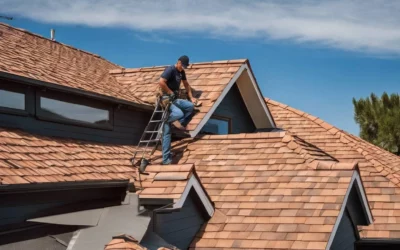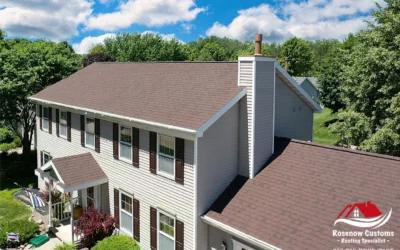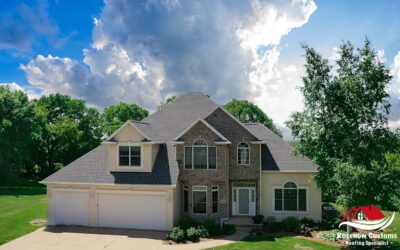Maintaining the integrity of your roof is a crucial aspect of home ownership. Regular roof inspections are an essential part of this process, ensuring the longevity of your roof and the safety of your home. For instance, with Rosenow Customs, their expertise in Roof Maintenance guarantees homeowners peace of mind, knowing their roofs are in capable hands. This article will guide you through the importance of regular roof inspections, how often they should be conducted, and what to expect during the process. Whether you’re a new homeowner or have been living in your home for years, this guide will provide valuable insights to help you navigate the world of roof inspections.
Understanding the Need for Regular Roof Inspections
The longevity and safety of your home hinge significantly on the condition of your roof. Regular roof inspections serve as a proactive measure to detect and address minor issues before they escalate into major, expensive repairs. These assessments can unearth hidden damages, extend your roof’s lifespan, and ultimately, save you a considerable amount of time and money. Grasping the factors that influence the frequency of roof inspections and the elements of a professional roof inspection are vital in maintaining a robust and secure roofing system. Ensuring your roof’s integrity isn’t a game of chance, but a necessary home maintenance task that can be effectively managed through routine roof inspections.
Significance of Regular Roof Inspections
Routine roof inspections offer a vital line of defense in preserving your roof’s condition. One of the primary advantages is the early detection of potential problems. These assessments can pinpoint vulnerabilities, leaks, or minor damages that, if neglected, could lead to extensive, costly repairs.
Another significant benefit of regular inspections is weather resilience. As the seasons shift, so do the demands on your roof. Regular assessments ensure your roof is prepared to withstand harsh weather conditions, reducing the risk of weather-related damage and prolonging the roof’s lifespan.
Furthermore, these inspections are instrumental in maintaining and even enhancing your property’s value. A well-maintained roof often signals to potential buyers that the property has been diligently cared for, positively influencing the property’s value.
Finally, regular roof inspections contribute to home safety by identifying potential hazards such as loose or missing shingles that could result in a collapse. By facilitating early detection of such issues, routine inspections not only protect your home but also provide peace of mind.
In summary, the significance of regular roof inspections lies in their preventative nature, mitigating potential financial burdens and ensuring safety. As previously mentioned, preserving your roof’s integrity is not an optional task, but a critical aspect of home maintenance – and regular roof inspections are at the heart of this endeavor.
Determinants of Roof Inspection Frequency
The frequency of roof inspections is not a one-size-fits-all scenario. A multitude of factors come into play, each contributing to the timing and regularity of these essential check-ups.
The lifespan of your roof is a key player in this equation. As roofs age, they naturally become more vulnerable to the elements, necessitating more frequent inspections. Conversely, newer roofs, with their fresh materials and recent installations, may not require as many check-ups.
The materials that make up your roof also have a say in the inspection frequency. For instance, roofs composed of long-lasting materials like slate or tile may not need as many inspections. On the other hand, those made from asphalt shingles or wood may require more regular visits due to their propensity for quicker deterioration.
Your geographical location and its associated climate can also influence the inspection schedule. Roofs in areas subjected to harsh weather conditions such as hailstorms, heavy snowfall, or intense sunlight may need more frequent assessments to keep potential damage in check.
Don’t forget the role of your surrounding environment. Trees near your property can pose a threat to your roof, with overhanging branches causing damage and fallen leaves blocking gutters, both of which can lead to water damage.
Lastly, a roof with a track record of issues may benefit from more regular inspections to prevent recurring problems. By considering these factors – the age and type of your roof, your location and local weather, nearby trees, and past roof damage – you can create a tailored inspection schedule that keeps your roof in optimal condition.
Elements of a Professional Roof Inspection
A professional roof inspection is a meticulous process that delves into the various components of your roofing system. While the specifics may differ among service providers, a comprehensive inspection typically includes the following:
Structural Inspection: This aspect focuses on the integrity of the roof, scrutinizing elements like sagging, the condition of the fascia and soffits, the chimney’s state, and ventilation. This step is crucial in identifying potential structural issues that could compromise the roof’s longevity.
Material Inspection: Here, the inspector looks for signs of wear and tear, such as missing or broken shingles, wear spots, stains, or rust on metal parts. They also assess the condition of the sealant and flashing.
Interior Inspection: This part involves a thorough check of the house’s interior for signs of water damage or leakage, such as water stains or mold in ceilings and attic spaces.
Workmanship Inspection: The inspector evaluates the quality of the roofing installation and any previous repairs, looking for mistakes that could lead to future issues or void a warranty.
Gutter and Drainage Inspection: This step involves ensuring the gutters and downspouts are functioning correctly, as they play a vital role in directing water away from the home to prevent damage.
Inspection Report: A professional inspection concludes with a detailed report, complete with findings, photographs, and recommendations for any necessary repairs or replacements.
By familiarizing yourself with these integral elements of a professional roof inspection, you can better understand your roof’s condition, make educated decisions about maintenance, and ultimately extend the life of your roof.
Navigating the Frequency of Roof Inspections
To ensure your roof remains in top condition and serves you for its full lifespan, scheduling regular inspections is paramount. However, the term regular can be subjective, varying based on several factors unique to your home. These factors include the age of your roof, the geographical location of your home, any previously detected issues, and more. In this segment, we will explore these different scenarios, ranging from routine to emergency situations, to help you gain a clearer understanding of the ideal timing for these vital roof assessments.
Recommended Routine Roof Inspections
The cornerstone of roof maintenance is routine roof inspections. As a rule of thumb, homeowners are advised to arrange for professional roof inspections at least biannually, ideally in the spring and fall.
Inspections in the spring can help identify and rectify any damage that might have been inflicted during the winter, a season notorious for its harsh impact on roofs due to ice and snow. On the other hand, a fall inspection serves as a preparatory measure for the upcoming winter, ensuring your roof is in prime condition to withstand any potential severe weather.
In addition to these professional inspections, it’s beneficial to conduct a visual inspection from the ground level immediately following any severe weather events. This proactive approach can help you detect issues like missing shingles, sagging gutters, or visible damage, which can then be examined more thoroughly by professionals.
Routine inspections should also include a search for biological growth such as mold, algae, or moss. These organisms tend to flourish in damp, shaded areas and, if left unchecked, can inflict substantial damage to your roofing materials.
In essence, the goal of routine inspections is to foresee and address issues before they escalate into major problems. By adhering to the recommended schedule for routine roof inspections, you’re not only safeguarding your roof but also making a wise investment for its future, potentially saving you from costly repairs or premature replacement.
Circumstances for Emergency Roof Inspections
While biannual inspections are the norm, certain unexpected situations may necessitate an immediate, or emergency, roof inspection. These scenarios often emerge without warning and could jeopardize the structural soundness of your home or even your personal safety. They encompass:
- Severe Weather Conditions: Following extreme weather events such as hailstorms, hurricanes, tornadoes, or heavy snowfall, an urgent roof inspection becomes imperative. These harsh conditions can inflict immediate and significant damage, including cracks, leaks, or dislodged shingles.
- Evidence of Water Damage: Observing signs of water damage within your home, like damp patches, mold, or water stains on your ceiling or walls, is a strong signal of a potential roof leak that requires immediate inspection.
- Post-Fire: In the aftermath of a fire incident in your house or the surrounding area, an inspection is crucial to evaluate any potential damage to the roof’s structural integrity caused by the intense heat or the water used to extinguish the fire.
- Impact from Falling Debris: Should a tree or large branch fall onto your roof, an emergency inspection is necessary to assess and rectify any resultant damage, such as crushed or punctured areas.
In these instances, it’s vital to act promptly and engage a roofing professional to inspect and rectify the damage. Prioritizing emergency roof inspections can avert further damage, protect your home’s structural integrity, and expedite the restoration of your roof’s durability and performance.
Inspections for Aging Roofs
As roofs age, they become more prone to wear and tear, increasing the likelihood of issues that can undermine their effectiveness. Understanding your roof’s age can inform the frequency of professional inspections.
For roofs over ten years old, annual inspections become increasingly important. Once your roof crosses the 15-year threshold, biannual inspections should be scheduled, irrespective of other factors. Roofs nearing or exceeding their typical lifespan (generally around 20-25 years for asphalt shingles, though this can vary based on the material), may necessitate more frequent monitoring, possibly with inspections recommended quarterly.
The goal of inspections for aging roofs is to detect common age-related issues such as granule loss in asphalt shingles, deteriorating roof flashing, sagging, leaks, and structural problems due to prolonged exposure to the elements. Moreover, as the roof ages, not just the surface shingles or tiles, but also the underlayment and decking may start to deteriorate, which will be detected during a thorough inspection.
It’s important to note that an older roof doesn’t necessarily mean a failing roof. However, more regular and detailed inspections ensure that any signs of deterioration are quickly identified and addressed, thereby extending the lifespan of your roof and preparing for an eventual replacement. The emphasis here is on proactive maintenance, identifying minor issues before they become major problems, and planning for future costs.
Executing a Roof Inspection
Having established the importance and frequency of roof inspections, it’s time to delve into the process of conducting these evaluations. This section will illuminate the steps involved in a comprehensive roof inspection, providing you with the knowledge to ensure your roof receives the thorough examination it needs. By understanding this process, you can play a proactive role in prolonging your roof’s lifespan and safeguarding your home’s value and safety.
Professionals and Roof Inspections
The role of professionals in roof inspections cannot be overstated. While a diligent homeowner may spot glaring issues like missing shingles or visible leaks, a professional roofing contractor brings a depth of expertise and a toolkit that goes beyond the surface.
These experts conduct a methodical examination of your roof, detecting not only apparent damages but also subtle indicators of potential problems that could escalate if ignored. Their trained eyes can identify minor leaks that could foster mold growth, weak areas that could risk a roof collapse, and absent seals that could allow pests and weather elements to infiltrate.
Having a professional traverse your roof is not only safer but also ensures a more thorough inspection. They can unearth deeper issues that could undermine your roof’s integrity in the long run.
Moreover, professional inspectors stay updated on the latest building codes and standards. Their evaluations can confirm your roof’s adherence to these regulations, providing you with peace of mind about your roof’s stability and safety.
In conclusion, while homeowners can conduct basic checks, a comprehensive assessment of a roof’s condition necessitates the services of a professional roof inspector. Their detailed examination and insights into potential problems can prevent unexpected repair and replacement expenses in the future.
Typical Process of a Roof Inspection
A comprehensive roof inspection is a meticulous process that leaves no room for oversight. While the specifics may vary slightly among different professionals, the general procedure remains consistent. Here’s a breakdown of what you can expect during a standard roof inspection:
Exterior Examination: The initial step involves a thorough assessment of the roof’s external appearance. Inspectors are on the lookout for any visible indications of damage, such as missing or curling shingles, compromised roof flashing, signs of water damage or rust, and any structural abnormalities.
Interior Evaluation: After the exterior, the focus shifts to the interior, typically the attic. Here, the inspector searches for evidence of water infiltration, which could appear as dark spots, streaks, or even mold on the ceiling or walls.
Structural Analysis: The inspector then evaluates the structural soundness of the roof. This includes checking the roof’s slope and alignment for any sagging, as well as inspecting the condition of the gutters, downspouts, chimney, and fascia to ensure they are securely attached and functioning as intended.
Material Assessment: The state of your roofing materials is next on the list. The inspector will estimate the age of your shingles or tiles and gauge their remaining lifespan.
Workmanship Review: The overall quality of the roof’s construction is scrutinized. Inspectors will identify potential leak-prone areas, such as pipe collars, valleys, and flashings.
Report & Recommendations: Upon completion of the inspection, you’ll receive a detailed report outlining the findings and suggesting any necessary repairs or replacements.
Understanding the roof inspection process can equip you to interact more effectively with your chosen inspectors and make well-informed decisions about any proposed actions. Remember, the goal of a roof inspection is to ensure the safety, longevity, and reliability of your roof.
1. What is the recommended frequency for roof inspections?
Roof inspections should usually occur twice a year. Experts generally recommend scheduling inspections in the spring and fall to assess any potential damage from winter snowfall or summer storms (Schroofing, 2019).
2. Why is it necessary to inspect my roof regularly?
Routine inspections can help spot early signs of roof damage and avoid expensive repairs. Consistent assessment will also prolong the roof’s lifespan and maintain its functionality (Billings Roofing, 2019).
3. How do environmental factors affect the frequency of roof inspections?
In regions where severe weather conditions prevail, more frequent roof inspections are advised. These checks can help identify damages from hail, heavy rain, wind, or snow much earlier (Top Customer Solutions, 2020).
4. Does the age of the roof impact the need for inspections?
Yes, the older a roof gets, the more vulnerable to wear and tear it becomes. Hence, older roofs require more frequent checks, preferably quarterly or semi-annually, to ensure they remain in good shape (Bonner, 2020).
5. Can I perform a roof inspection myself, or should I hire a professional?
While homeowners can do basic checks, professionals have the training to identify subtle signs of roof damage. Therefore, hiring a qualified expert is always advisable for comprehensive inspections (Prestige Roofing, 2018).
6. How can regular roof inspections save money in the long term?
Regular roof inspections can save money by identifying small issues before they escalate into severe damage. Early detection often results in minimal repair costs compared to major fixes or roof replacements (Maintenance Solutions, 2020).




